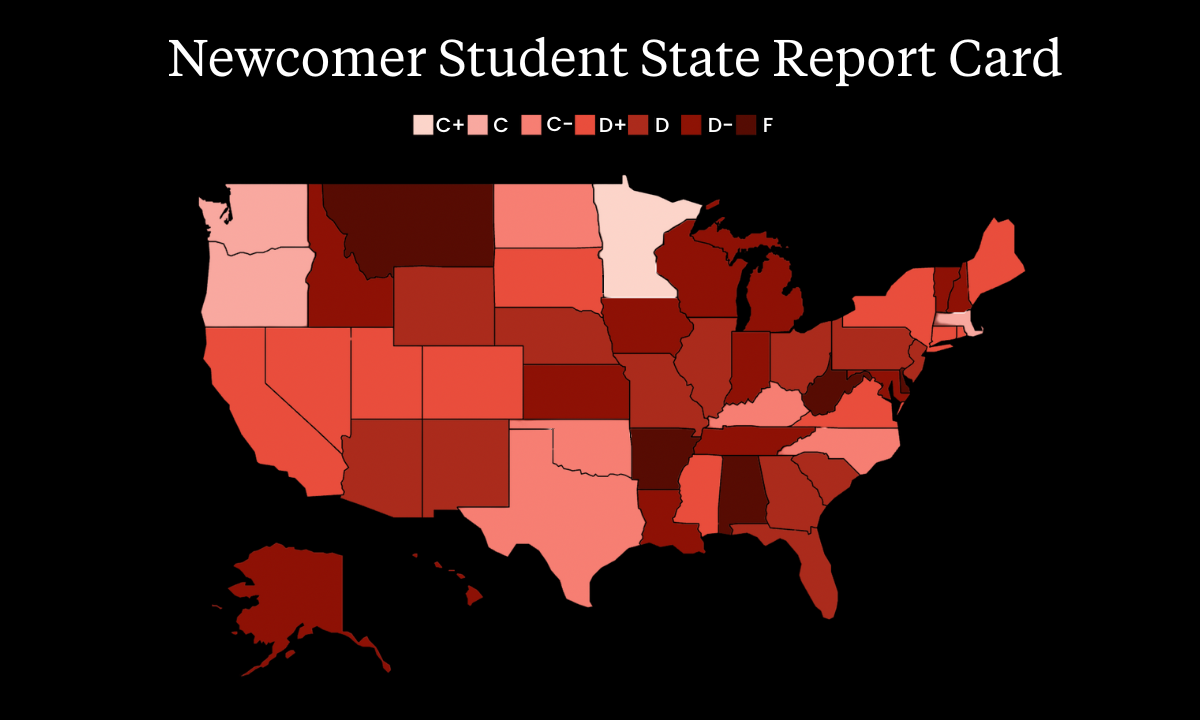New Study: Not One State Adequately Supports Immigrant Students
The Century Foundation graded states on how they define newcomer students, collect and report data on their progress and fund their educational needs.

Get stories like this delivered straight to your inbox. Sign up for The 74 Newsletter
Not a single state in the union adequately supports newcomer students, according to an analysis by The Century Foundation, a progressive think tank focused on educational equity.
In a report released today, the foundation and its offshoot, Next 100, scored state education departments on whether and how they define immigrant students, collect and report data on their educational progress and fund programs that support them.
They assigned grades to all 50 states and Washington, D.C., based upon their findings: None won a mark above a C+. Forty-two states scored between C- and D- and five — Alabama, Arkansas, Delaware, Montana and West Virginia — earned an F.
The results come as the Trump administration continues to zero in on this vulnerable student population as part of its multibillion-dollar immigration crackdown: Young people have been arrested, detained — in the case of one Los Angeles teen this month, at gunpoint — and deported.

The federal government also recently rescinded rules directing schools to accommodate English learners. Immigrant advocates are pleading with state lawmakers to push back by showing their support for these students and better preparing teachers to meet their needs.
“We are witnessing a sinister daily attack on our immigrant neighbors from a federal government bent on stripping immigrants’ access to work, health care, educational opportunities, and even their sense of safety,” said report co-author Alejandra Vázquez Baur, a foundation fellow who heads its National Newcomer Network. “All students show up with a twinkle in their eye, excited to learn — newcomers included — and states need to do more to support them.”
The Century Foundation, founded as the Co-operative League in 1919, recommends states develop specific and consistent definitions for this population, which includes refugees, asylum seekers, unaccompanied minors and migratory children.
In an effort to better serve this diverse and largely growing student body — there are more than 1 million immigrant students inside the nation’s K-12 public schools — agencies must also collect and publish data on key indicators about their educational experiences, including years in the United States, English proficiency, home language, prior schooling and academic outcomes. Such data points might include school engagement, participation in clubs and sports and any behavioral issues that could arise in school, the foundation concludes.
State education agencies should use the data to inform funding formulas, the report recommends, and to create a newcomer-specific funding structure that supplements federal money. This additional aid should provide support for students in their first few critical years in the public schools system, “with transparent reporting on its use and impact.”
The report highlights the scattershot nature of data collection across the country: 17 states collect no discernable data on immigrant students at all. Twenty-two compile such information to determine eligibility and maintain compliance with federal Title III funds earmarked for English learners.
Eight states collect data that might include newcomers, but it isn’t differentiated or used to determine how supports are allocated. Only four have clear definitions of the term “newcomer” and consistently collect robust data about these children.
Oregon requires all districts to submit what it calls Recent Arrivers data and uses the information for federal reporting and to allocate Title III funds, according to the analysis. Kentucky collects disaggregated immigrant student data annually and later divides it by subgroup, while Washington state, according to the researchers, requires districts to track all eligible English learners in their student information systems and report key data points like birth country and U.S. school enrollment date.
But North Dakota outdoes them all, the study shows: It publicly reports disaggregated English learner data by year, including counts and percentages of immigrant, refugee and migrant students, among other groups, and breaks down this data by district, home language and ethnicity. The state, population 779,094, had less than 28,000 immigrant residents in 2023. Nearly 84% were of working age.
“This is exemplary,” the report notes of North Dakota’s approach, adding it allows for a clearer understanding of the diverse needs within this student population and supports targeted interventions for many children, including those with limited or interrupted formal education.
The report cites the unevenness of young immigrants’ educational experience, as they sometimes move between districts striving for stable housing.
“When these programs differ across district lines within a state, this group of often highly mobile marginalized students may not qualify for comparable services when they move, and their new schools may not receive the resources they need to properly serve them,” the report reads. “State education agencies have the unique opportunity to address these inconsistencies to best support all students, including newcomers.”
English learners nationally had a 71% high school graduation rate, as of the 2019-20 school year, compared to the 86% national average.
At a moment when anti-immigrant fervor was beginning to build in this country, The 74 last year tested the enrollment practices of more than 600 high schools, attempting to register a 19-year-old newcomer who spoke little English and whose education had been interrupted. More than 300 schools refused to register him — including 204 denials in the 35 states and the District of Columbia where high school attendance goes up to at least age 20.
Vázquez Baur said newcomer students are here to stay and their presence predates the laws guaranteeing them educational access, including the 1982 Supreme Court case, Plyler v. Doe. The quality of their education, she said, will determine not only their opportunity but the health and well-being of their communities.
“Newcomers students are in our classrooms regardless of what our president says,” she said. “They are valuable neighbors and students. They become valuable leaders in their communities. Especially at this moment, it is the states that are on the front line against the federal government.”
Get stories like these delivered straight to your inbox. Sign up for The 74 Newsletter

;)
